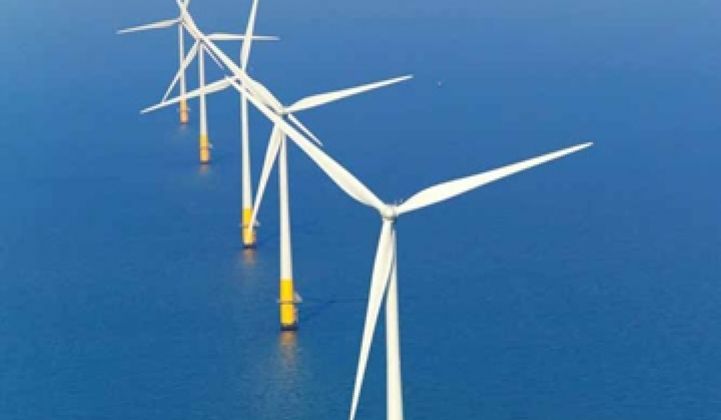North Carolina could become the first state in the country to see wind turbines planted in offshore waters.
Charlotte-based Duke Energy (NYSE: DUK) is funding a pilot project to erect up to three wind turbines in Pamlico Sound, the company said Tuesday. The project is taking shape as a result of a nine-month, 378-page study recently completed by the University of North Carolina at Chapel Hill (see study).
The state's General Assembly tapped the university to carry out the feasibility study for offshore wind resources, construction challenges, electric transmission infrastructure, environmental impact, regulatory processes and the economics. The university plans to continue its research via the pilot project. The study also raised questions that could be better answered through a pilot project, such as the impact of the tropical storms and behavior of different bird species around wind turbines.
"There aren't wind turbines installed elsewhere that could have endured conditions from a tropical storm - we want to know what will it do to the turbine blades or the foundation," said Carolyn Elfland, associate vice chancellor for campus services at the university.
Duke has committed to investing up to $35 million to construct the pilot project, Elfland said. No money would come from the state and the university.
The project would enable Duke to assess the technical challenges and market potential for offshore wind energy, which holds tremendous promise but is only in the early stages of development in the United States.
Duke already is an enthusiastic onshore wind farm owner. The company is operating 634 megawatts of wind farms in Pennsylvania, Texas and Wyoming, and is building another 99 megawatts. The utility serves about 4 million electric customers in both of the Carolinas, as well as Ohio, Kentucky and Indiana.
The Atlantic coast could be home to more than 1 gigawatt of offshore wind farms, said the National Renewable Energy Laboratory (NREL). NREL has pegged the potential at roughly 900 megawatts off the Pacific coast.
The U.S. Department of Interior said about 2 gigawatts of offshore wind projects have been proposed in the United States. But none has been built (see Feds Issue First-Ever Offshore Wind Leases).
Technical and regulatory hurdles are difficult to overcome. So is the opposition from communities close to the proposed wind farms.
The university and Duke have only recently begun to plan for the pilot project, and they have yet to map out a timeline and intermediate goals, Elfland said.
The state did ask the university to try to get the turbines up and running by September 2010, she added.
One of the Duke's goals is to figure out how much it would cost to operate an offshore wind farm, said Tim Pettit, a Duke spokesman. Duke hasn't decided who should supply the turbines and might end up working with a manufacturer who is willing to help pay for part of the project's cost, Pettit added.
Duke and the university have proposed to set up the wind turbines in Pamlico Sound, in an area between the mainland and an island that is part of a string of islands along the coast that is commonly called the Outer Banks. The equipment would go up about seven miles west of the island in the Pamlico Sound, in water about 16 to 20 feet deep, Elfland said.
The two project participants held a meeting for residents of the Outer Banks last month, a gathering that brought out Gov. Beverly Perdue, state Sen. Marc Basnight and state Rep. Tim Spear.
Getting community support would be crucial, of course. Up in Massachusetts, a proposed 420-megawatt wind farm called Cape Wind has encountered strong resistance from communities around Nantucket Sound and some lawmakers.
Cape Wind developer first proposed the project eight years ago. It received a crucial environmental approval from the federal government earlier this year, but when it could secure all the necessary permits and get start with construction remains unclear.
Elfland said the university researchers not only studied Pamlico Sound but also the Albemarle Sound and waters east of Outer Banks. They stopped in areas that are more than 30 meters deep, according to the study.
The researchers concluded that Albemarle Sound isn't a good location for wind farms. The area would offer lighter winds than Pamlico Sound, and it's too close to military space and home to heavy bird population.
The university also wanted the pilot project to be close to shore so that its researcher could have an easier access to the wind turbines, Elfland said. The project would be built in state water, eliminating its need to get permits from the Interior Department. It would require approval of the state and the Army Corps of Engineers.
Photo of a Kentish Flats offshore wind farm in the U.K. via Vattenfall.



